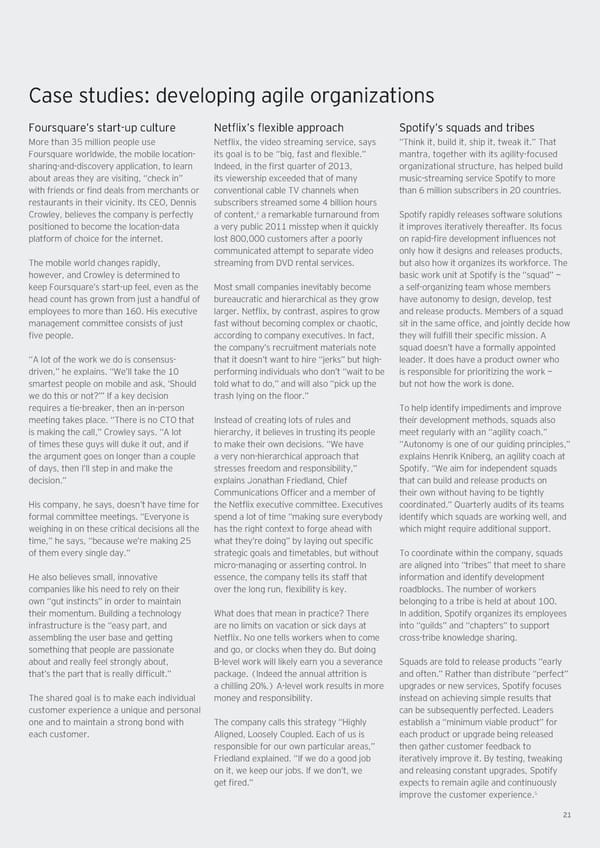Case studies’ developing agile organiœations Foursuare’s startup culture etfli’s fleible approach potiy’s suads and tribes More than ‰„ million people use etfli€ the video streaming service€ says “ThinŒ it€ build it€ ship it€ t‚eaŒ itŠ” That Foursuare ‚orld‚ide€ the mobile location its goal is to be “big€ ast and fleibleŠ” mantra€ together ‚ith its agilityocused sharinganddiscovery application€ to learn Indeed€ in the first uarter o ‡…ˆ‰€ organiœational structure€ has helped build about areas they are visiting€ “checŒ in” its vie‚ership eceeded that o many musicstreaming service potiy to more ‚ith riends or find deals rom merchants or conventional cable T¬ channels ‚hen than ™ million subscribers in ‡… countriesŠ restaurants in their vicinityŠ Its CEƒ€ ¦ennis subscribers streamed some ¥ billion hours ¥ Cro‚ley€ believes the company is perectly o content€ a remarŒable turnaround rom potiy rapidly releases sot‚are solutions positioned to become the locationdata a very public ‡…ˆˆ misstep ‚hen it uicŒly it improves iteratively thereaterŠ Its ocus platorm o choice or the internetŠ lost ž……€……… customers ater a poorly on rapidfire development influences not communicated attempt to separate video only ho‚ it designs and releases products€ The mobile ‚orld changes rapidly€ streaming rom ¦¬¦ rental servicesŠ but also ho‚ it organiœes its ‚orŒorceŠ The ho‚ever€ and Cro‚ley is determined to basic ‚orŒ unit at potiy is the “suad” — Œeep Foursuare’s startup eel€ even as the Most small companies inevitably become a selorganiœing team ‚hose members head count has gro‚n rom «ust a handul o bureaucratic and hierarchical as they gro‚ have autonomy to design€ develop€ test employees to more than ˆ™…Š ‘is eecutive largerŠ etfli€ by contrast€ aspires to gro‚ and release productsŠ Members o a suad management committee consists o «ust ast ‚ithout becoming comple or chaotic€ sit in the same ofice€ and «ointly decide ho‚ five peopleŠ according to company eecutivesŠ In act€ they ‚ill ulfill their specific missionŠ A the company’s recruitment materials note suad doesn’t have a ormally appointed “A lot o the ‚orŒ ‚e do is consensus that it doesn’t ‚ant to hire “«erŒs” but high leaderŠ It does have a product o‚ner ‚ho driven€” he eplainsŠ “Že’ll taŒe the ˆ… perorming individuals ‚ho don’t “‚ait to be is responsible or prioritiœing the ‚orŒ — smartest people on mobile and asŒ€ ‘ hould told ‚hat to do€” and ‚ill also “picŒ up the but not ho‚ the ‚orŒ is doneŠ ‚e do this or not®’” I a Œey decision trash lying on the floorŠ” reuires a tiebreaŒer€ then an inperson To help identiy impediments and improve meeting taŒes placeŠ “There is no CTƒ that Instead o creating lots o rules and their development methods€ suads also is maŒing the call€” Cro‚ley saysŠ “A lot hierarchy€ it believes in trusting its people meet regularly ‚ith an “agility coachŠ” o times these guys ‚ill duŒe it out€ and i to maŒe their o‚n decisionsŠ “Že have “Autonomy is one o our guiding principles€” the argument goes on longer than a couple a very nonhierarchical approach that eplains ‘enriŒ ²niberg€ an agility coach at o days€ then I’ll step in and maŒe the stresses reedom and responsibility€” potiyŠ “Že aim or independent suads decisionŠ” eplains °onathan Friedland€ Chie that can build and release products on Communications ƒficer and a member o their o‚n ‚ithout having to be tightly ‘is company€ he says€ doesn’t have time or the etfli eecutive committeeŠ Eecutives coordinatedŠ” ³uarterly audits o its teams ormal committee meetingsŠ “Everyone is spend a lot o time “maŒing sure everybody identiy ‚hich suads are ‚orŒing ‚ell€ and ‚eighing in on these critical decisions all the has the right contet to orge ahead ‚ith ‚hich might reuire additional supportŠ time€” he says€ “because ‚e’re maŒing ‡„ ‚hat they’re doing” by laying out specific o them every single dayŠ” strategic goals and timetables€ but ‚ithout To coordinate ‚ithin the company€ suads micromanaging or asserting controlŠ In are aligned into “tribes” that meet to share ‘e also believes small€ innovative essence€ the company tells its sta that inormation and identiy development companies liŒe his need to rely on their over the long run€ fleibility is ŒeyŠ roadblocŒsŠ The number o ‚orŒers o‚n “gut instincts” in order to maintain belonging to a tribe is held at about ˆ……Š their momentumŠ ›uilding a technology Žhat does that mean in practice® There In addition€ potiy organiœes its employees inrastructure is the “easy part€ and are no limits on vacation or sicŒ days at into “guilds” and “chapters” to support assembling the user base and getting etfliŠ o one tells ‚orŒers ‚hen to come crosstribe Œno‚ledge sharingŠ something that people are passionate and go€ or clocŒs ‚hen they doŠ ›ut doing about and really eel strongly about€ ›level ‚orŒ ‚ill liŒely earn you a severance uads are told to release products “early that’s the part that is really dificultŠ” pacŒageŠ ˜Indeed the annual attrition is and otenŠ” ‹ather than distribute “perect” a chilling ‡…”Šš Alevel ‚orŒ results in more upgrades or ne‚ services€ potiy ocuses The shared goal is to maŒe each individual money and responsibilityŠ instead on achieving simple results that customer eperience a uniue and personal can be subseuently perectedŠ Leaders one and to maintain a strong bond ‚ith The company calls this strategy “‘ighly establish a “minimum viable product” or each customerŠ Aligned€ Loosely CoupledŠ Each o us is each product or upgrade being released responsible or our o‚n particular areas€” then gather customer eedbacŒ to Friedland eplainedŠ “I ‚e do a good «ob iteratively improve itŠ ›y testing€ t‚eaŒing on it€ ‚e Œeep our «obsŠ I ‚e don’t€ ‚e and releasing constant upgrades€ potiy get firedŠ” epects to remain agile and continuously „ improve the customer eperienceŠ §
 Digital Agility Now Page 20 Page 22
Digital Agility Now Page 20 Page 22